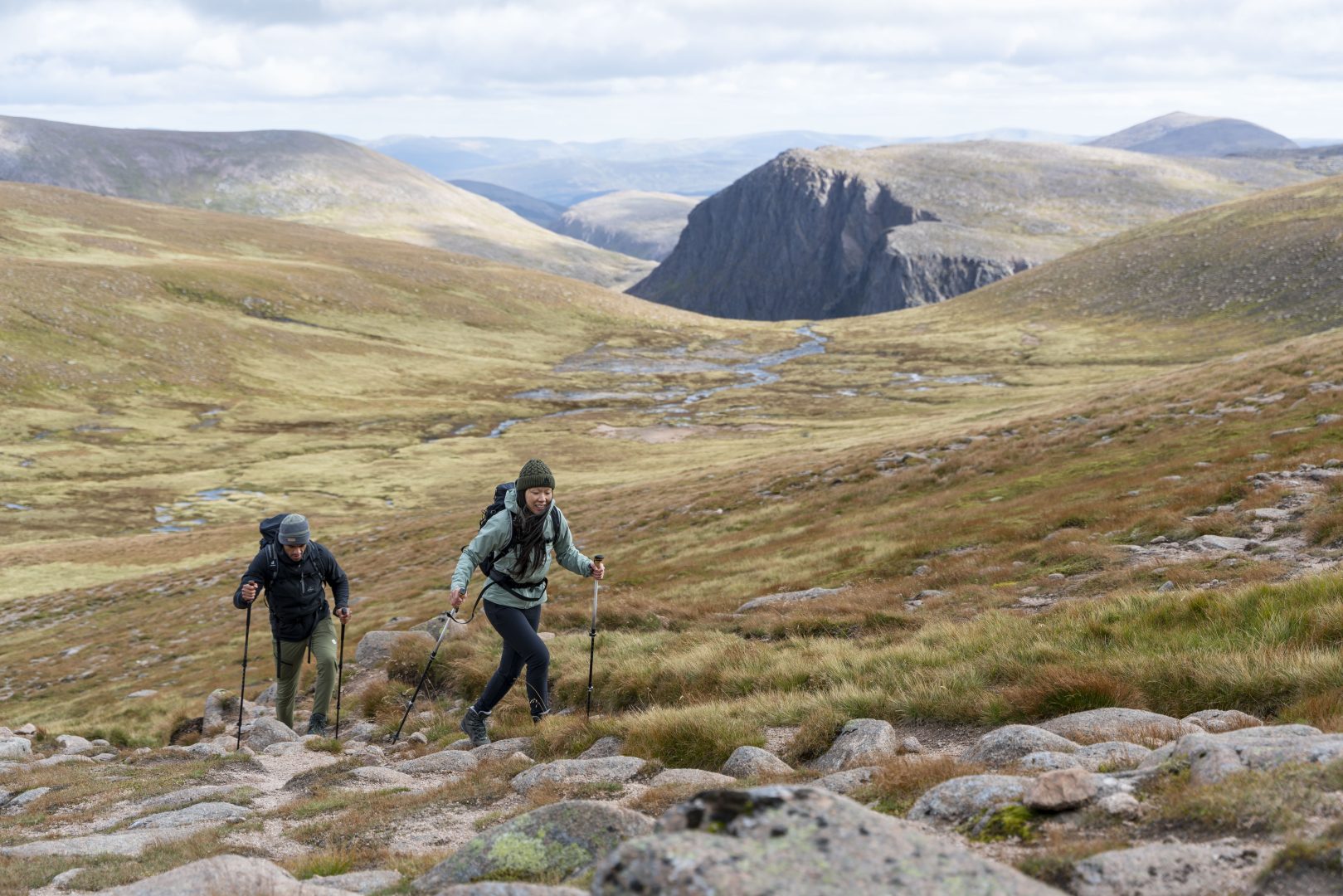A buyers’ guide for hiking poles and Nordic poles
The simple wooden walking stick has gone high-tech! This is a quick look at why you might want a pair of hiking poles, and what sort of features to look for when you are choosing them. Some people refer to hiking poles as walking poles or trekking poles. There is a huge choice of hiking poles on the market, in this post we will help you understand how to use hiking poles and why you should think seriously about investing in a pair to protect your joints and help with quick post hike recovery. If you’re new to hiking you should read our Hiking For Beginners Guide.
Hiking Poles are not just for people with dodgy knees!
Hiking poles can actually prevent you getting dodgy knees and can help improve recovery time!
Are Hiking Poles Just For Old People?
No! There’s a myth that hiking poles are something you should only need when you have dodgy knees. This is not true, the beauty of hiking poles is that they can help even the fittest hikers to prevent joint damage. This can extend your fun hiking on the day or the hiking holiday, but importantly it can mean that you delay or entirely prevent the damage on those essential hiking joints – your knees!
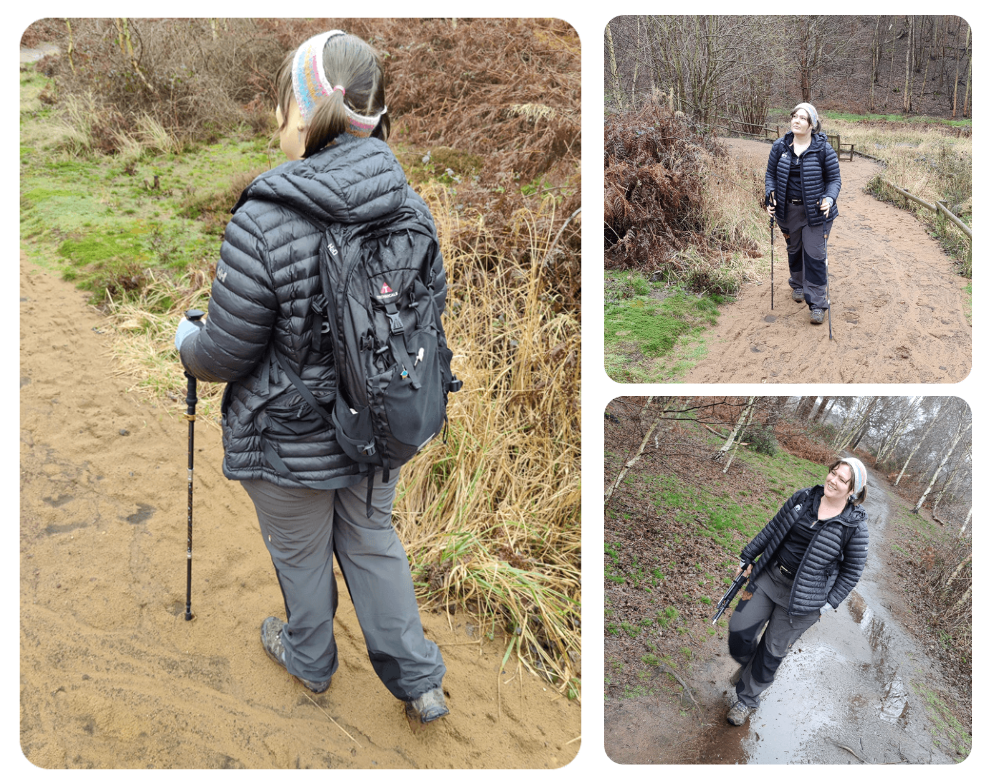
Reduced Impact on Joints
Hiking Poles reduce the impact forces of walking, especially if you are carrying a heavy pack or going downhill. By taking some of the load on the poles, your knees, ankles, hips and spine take a little bit less. If you are older or have existing joint problems this can make a huge difference.
Increased Stability
Hiking Poles give extra stability on rough terrain and reduce the chance of slips or falls by providing an extra point of contact with the ground
Increased Speed
Hiking Poles can help you walk faster, especially on the level or downhill by using your arm muscles as well as your legs. The Nordic walking style poles especially focus on this.
Checking Depth of Snow and Water
Hiking Poles can be useful for checking snow depth, water depth, rigging a shelter, creating an emergency anchor or even splinting a leg.
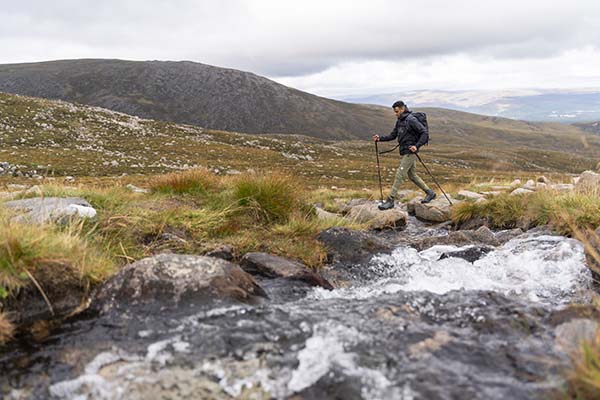
Some people will use hiking poles all the time. Others to only use them for longer or steeper routes where the benefits are more obvious, and stow them when not needed – many packs have a loop specifically to take them, or you can fit more compact poles in your pack.

EXPLORE THE
OS Shop
We are with you every step of the way. Shop our trusted walking and hiking maps and guidebooks so you can explore the outdoors with confidence.
Go to the shopTypes of Hiking Poles
Hiking poles are typically used in pairs, and there are several types available.
Are folding or telescopic walking poles better?
Choosing between folding and telescopic walking poles depends on your specific needs. Folding poles are extra lightweight and can fit inside your rucksack, making them ideal for multi-day treks. Telescopic poles, on the other hand, are more durable and adjustable, suitable for a wide range of terrains and user heights, which makes them a better choice for everyday one-day adventures. Ultimately, the best option will depend on the type of hiking or trekking you plan to do.

Telescopic Hiking Poles
Easier to adjust
Suitable for a wide range of terrains

Folding Hiking Poles
Extra Light Weight
Best for multi-day hiking
Nordic Poles
Nordic poles are specialist walking poles, used with a technique more like cross country skiing. See a Beginner’s Guide to Nordic Walking here.
What Are the Best Hiking Poles Made Of?
Hiking Poles can be made from wood, steel, aluminium, fibreglass or carbon fibre. Most basic ones are aluminium, which provides a good balance of weight, strength, durability and cost.
Higher end hiking poles are now available in carbon fibre and similar materials. These can be lighter (or stronger for a given weight), but tend to cost more, so are aimed at those doing more demanding activities.
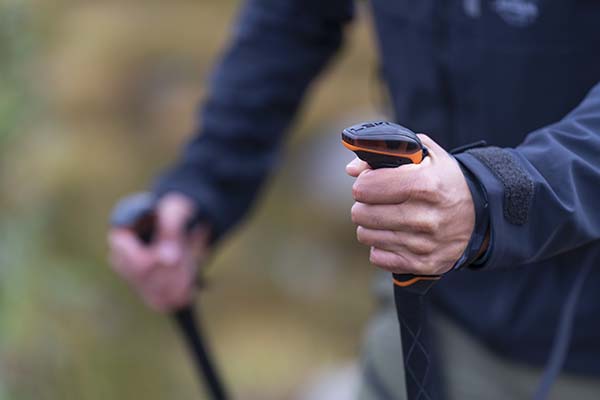
Regular Hiking
Aluminium is durable, light and there’s a wide range of price points depending on the other features you want. If you do a lot of hills look for ones that are easy to adjust the height. If you do a lot of walking on hard-packed tracks or paved roads ensure you can fit rubber tips for better grip.
Long Distance Hiking
For long distance walkers, wild campers and extreme adventurers, every gram counts. Modern materials like carbon fibre give lighter poles which reduce fatigue in use, and smaller size folding poles allows you to get them in a pack more easily. Make sure baskets are available for snow.
How To Use Hiking Poles
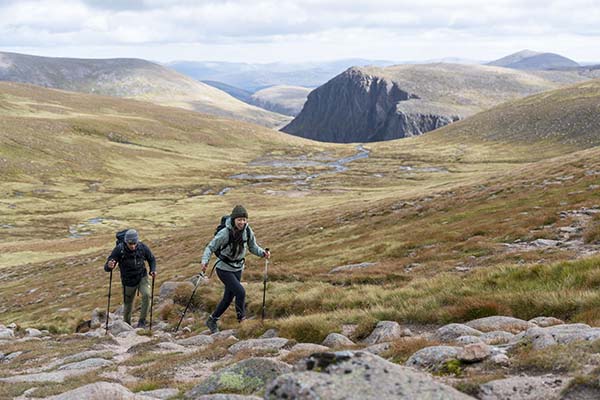
1.Adjust the length of the hiking poles based on the terrain (shorter for uphill, longer for downhill).
2.Test them on the ground; your arms should be relaxed and at a right angle when holding the poles.
3. Use trekking poles asymmetrically (when your right foot goes forward, your left pole should go forward with it and vice versa).
4. The poles should always be angled forward in your direction of travel.
5. When walking uphill, have the poles more in front of you so that you can push up and lift with your other foot.
6. When walking downhill, take your hands out of the pole straps, place your hands on top of the poles, and distribute all of your weight through the poles. The poles should be angled a bit more towards you to distribute the weight down the end of the pole.
7. The proper way is to use the strap is for it to come through the bottom and have the strap rest on your wrist with your thumb over the top of the strap. Alternatively, you can come through the bottom and have the strap over the back of your hand.
Getting the right size Hiking Poles
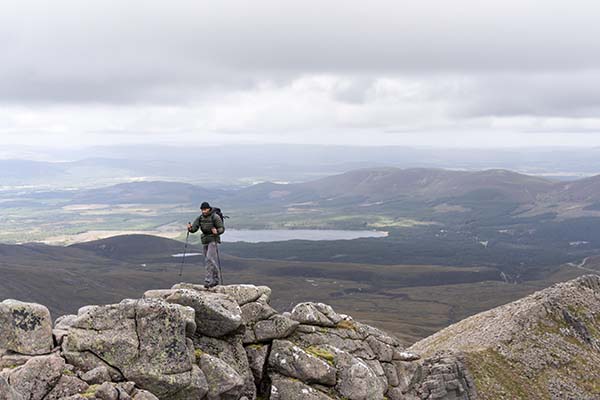
For walking poles and staffs, you would normally be holding them so that your elbow is at 90 degrees when the pole is held upright on the ground. Most modern poles are adjustable, but if you are taller or shorter than normal you might need to check the minimum and maximum heights. Many (especially walking staffs) have large grip areas, allowing you to adjust your grip as needed to deal with the terrain.
Being able to quickly adjust the height, either by adjusting the pole or how you hold it, allows you to use them more effectively. On uphill slopes, shorten them by about 10-15cm so you can easily plant them uphill and use the extra leverage to support your step. On downhill slope lengthen them by 10-15cm so you can plant them ahead of your feet without leaning forwards
Nordic poles tend to be slightly longer – typically your height x 0.68. If sizing to your body, when held upright your arm should be at an angle of slightly more than 90 degrees. Nordic poles are planted behind you and used to push forward on flatter terrain, so on uphill slopes you will need to shorten them a bit.
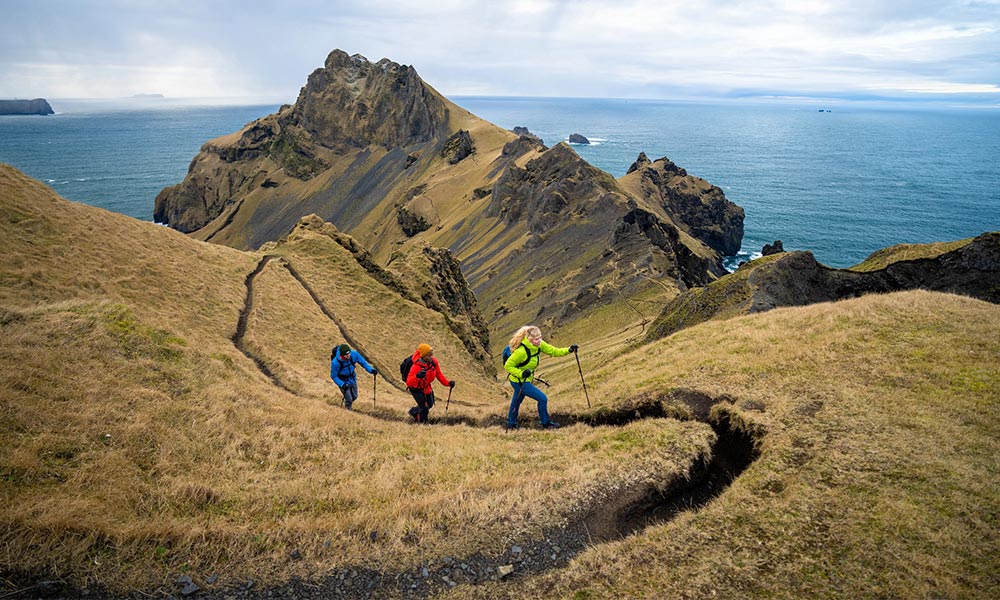
Which kind of hiking pole grip is best?

Grips are critical to comfort with your hiking poles, and can be made of various different materials each with their own pros and cons.
Cork Hiking Pole Grips
Cork which is a natural material, and good for hot weather. It also tends to mould a bit to your hands over time, so can make a really comfy grip.
Rubber Hiking Pole Grips
Rubber, which is tough and warmer in low temperatures (especially for metal poles). Can cause blisters as they get a bit sweaty.
Foam Hiking Pole Grips
Foam, soft and easy to add to poles with extended grips. Can get squishy in the wet, and cheaper foam tends not to be very durable.
The more shaped a grip is, the easier it will be to control the pole, but the more it limits how you hold it. Some poles, especially staffs, will have an extended foam grip allowing you to hold it at different points which is much faster than stopping to adjust height if you are on variable terrain.
Types of Hiking Pole Height Adjusters
Height adjusters allow you to easily lock the pole to the height you want. There are two main types. The clamp type has a small lever, and is quicker to adjust, especially wearing gloves. Twist to lock types tend to be more compact. Top tip: If there are two or more adjustors, ensure the top one is roughly centralised when it’s at the right length. It makes it easier to adjust pole length as needed.
Hiking Poles with Shock Absorbers
Shock absorbers reduce the impact forces, and are now seen in some poles. They can use springs or rubber bushes, and may be in the handle or part of the shaft. Most only move a small amount, but it’s enough to reduce the sudden impact force on your wrists and shoulders, especially downhill
Why do you need Wrist Straps on Hiking Poles?
Wrist straps stop you losing your poles down a scree slope. For most poles, this is a simple strap that’s over the wrist. Adjust it to be a fit where you can get just your hand in and out easily, and the strap can be used to apply a bit more force on the uphill, reducing grip effort a little. For Nordic poles, the wrist straps are a critical part to allow you to get more force on the push, so will be more elaborate, and usually made from some moisture wicking material like neoprene.
Different Kinds of Hiking Pole Tips
Tips can be hard spikes for digging into earth and sand, with carbide being more durable than steel, or rubber for grip on tarmac or stone – most poles can have a rubber tip fitted over the spike to convert them. The rubber tips will wear out, but replacements tend to be fairly easy to find. Some poles also some with an optional ‘basket‘, which stops it sinking as much in very soft materials, especially snow or bogs. If your poles come with baskets, you normally remove them unless conditions warrant it.
Choosing the right hiking poles for you!
Benefits of Using Hiking Poles, a quick recap of why you should get yourself a pair if you are getting into hiking.
- Distribute the weight of the pack and your body directionally through the hiking poles.
- Provide more stability under heavy loads and less strain on your body.
- Help you to hike further over the long term and maintain joint health.
- Can be used for multiple purposes such as mounting a camera or setting up trekking pole tents.

EXPLORE THE
OS Shop
We are with you every step of the way. Shop our trusted walking and hiking maps and guidebooks so you can explore the outdoors with confidence.
Go to the shop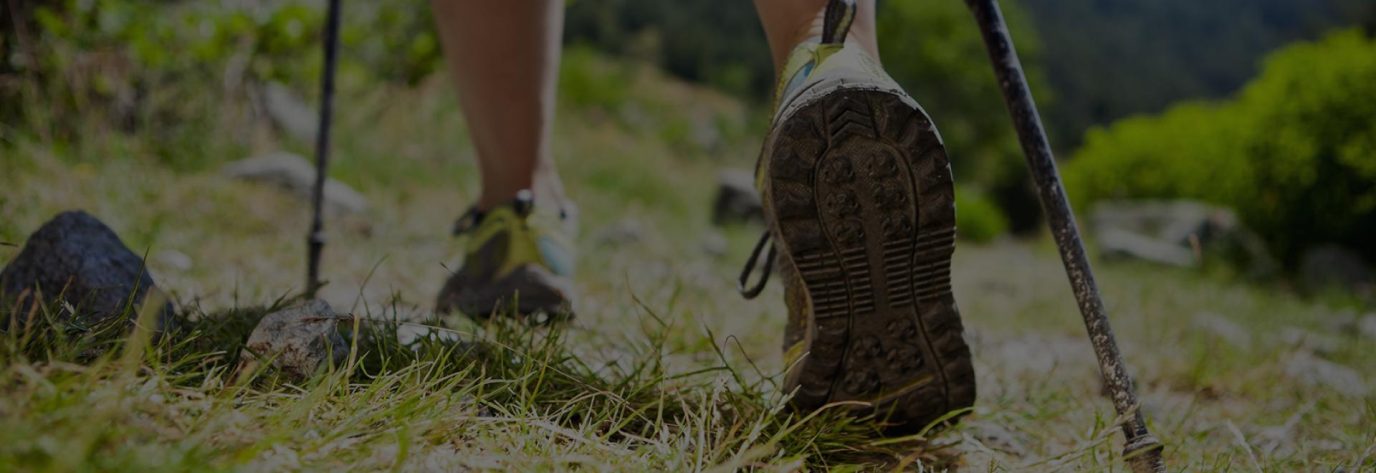
A beginner’s guide to nordic walking
Nordic Walking is a fast growing pasttime activity in Britain. Discover more with this beginner’s guide.
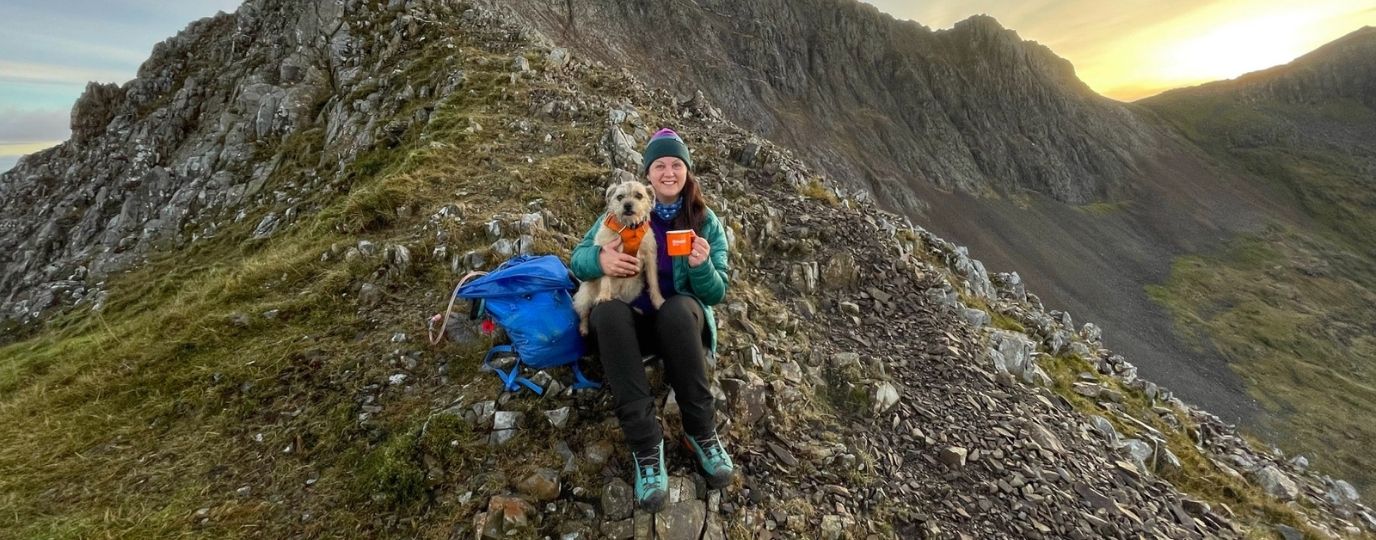
Hiking for Beginners – A Complete Guide
Hiking for beginners, a complete guide to hiking safety, hiking fitness and the best UK Routes for beginners

A Beginner’s Guide to Understanding Map Contour Lines
Learn the use and meaning of contour lines on a map and understand how to use them to when you’re out and about or planning routes. Understanding contours will improve your map reading skills.
EXPLORE WITH
OS Maps
Get more from the outdoors with OS Maps. Whether you’re planning a mountain hike, taking the kids for a woodland bike ride, or looking to discover a new local adventure, OS Maps helps you explore with more confidence.
Discover thousands of ready-made routes from outdoor experts; view & download maps directly to your phone, or print from your computer.
With trusted mapping, route planning tools & features, created by Ordnance Survey; OS Maps helps you make the most of your time outside.

EXPLORE THE
OS Shop
Ordnance Survey are the experts in mapping. Shop our selection of UK Maps for hiking, walking and your next outdoor adventure. Plus don’t miss our selection of essential walking guidebooks.
Whether you’re exploring the breathtaking landscapes of the UK’s National Parks or enjoying a serene coastal getaway, our paper maps are your indispensable travel companion.
Go to the shop
